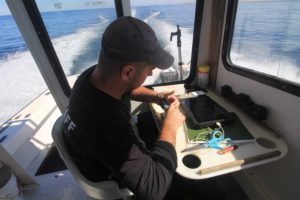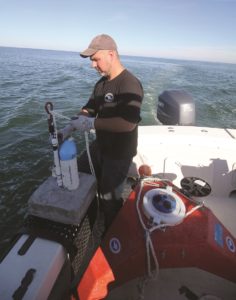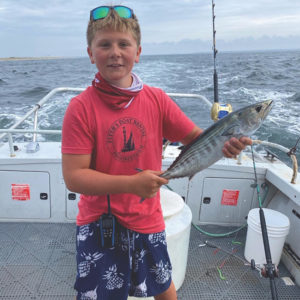Summer on Cape Cod has become synonymous with sharks.
Spotter planes patrol the skies for dark shapes in the water. Signs at ocean beaches post warnings with menacing illustrations. News outlets promote cell-phone videos of sharks attacking seals. Great white sharks have captured the attention of this place like little else.
Until recently, however, no one could tell you how many sharks were in our waters.
“By far the question we get asked the most is ‘How many sharks are out there?’ ” said Megan Winton, a fisheries scientist with the Atlantic White Shark Conservancy. Winton was the lead author of a study, published on July 27 in the scientific journal Marine Ecology Progress Series, that attempted to estimate how many of these predators visit Cape Cod each year.
Great white sharks are a highly migratory species. The ones that summer here spend their winters thousands of miles away in warmer waters around the southeastern U.S. In spring, these sharks begin moving north, and many of them are drawn to Cape Cod by its significant seal population.

To arrive at their numbers, Winton and her colleagues became what she termed “shark paparazzi.” Whenever a spotter plane found a shark, Winton and her team snuck up to it with a boat and used a GoPro camera on a pole to film it underwater. If they could, they would tag the shark with a radio transmitter to track it, too. They used this footage to identify unique markings on each shark, distinguishing them by their color patterns and scars. Each shark got a name like Avalanche, Gooz, and Mr. Spotclaw.
Winton mentioned that the team became so familiar with these sharks that they could recognize some of them by eye from the surface.
Winton then tracked how many times each shark was spotted again, either by her team or by its radio transmitter being detected by a buoy. She then took these numbers and plugged them into a complex statistical model to generate an estimate of how many sharks call the Cape home for part of the year.
The team estimated that at least 800 great white sharks visited Cape Cod over the course of the four-year study. The figure is similar for other aggregations of white sharks in places like South Africa and southern Australia. Winton noted, however, that the aggregation here is unusually dense compared to other white shark hotspots.
Winton’s team also found that the shark population here peaks in late summer and early fall — and at those times it can reach very high numbers. In one survey they found 31 white sharks present, with many more likely going undetected.
It’s important to understand that not all 800 of the sharks estimated to have visited over a four-year period are here at once, Winton said. She compared Cape Cod to a restaurant and the white sharks to customers: “Every restaurant has some regulars. And some people who just stepped through once and are like, ‘Eh, it’s all right.’ ”
Baseline measurements like Winton’s help illuminate changes in the white shark population. Overfishing and prey depletion likely caused white sharks to decline by as much as 80 percent by the end of the 20th century, and it is only because humans are protecting both the sharks and their seal prey that sharks have returned to the Outer Cape, according to Winton.
The new estimate matters to scientists like Bryan Legare, a seascape geologist who heads the Shark Ecology Research Program at the Center for Coastal Studies. He is one of those looking to understand and protect Cape Cod’s sharks. “We were culpable in reducing shark populations to historic lows in the ’70s and ’80s,” he said, so we have a duty to restore those populations.
Based on Winton’s findings, the recovery is “a very hopeful story,” she said. “When I got interested in shark research as a kid, shark populations across the board were tanking. I didn’t anticipate being on the other side of things this early.”
The return of white sharks to Cape Cod, however, does present a danger to humans. “The ocean is a wild environment,” said Winton, by which she means there is no way to be 100 percent safe from sharks in the water. “Anytime you’ve got big predators overlapping in areas that people use, sometimes there are going to be incidents.”
The next phase of Winston’s research will investigate when and where sharks are moving and feeding on the Outer Cape. She hopes those findings will help people avoid encounters with sharks.



 The Atlantic White Shark Conservancy reported 25 separate ocean beach closures because of shark sightings on the Outer Cape in the week ending Tuesday: 5 in Provincetown, all at Race Point; 10 in Truro, including 6 at Head of the Meadow, 2 at Coast Guard, and 2 at Ballston; 9 in Wellfleet, including 5 at Newcomb Hollow, 2 at Cahoon Hollow, and 2 at Lecount Hollow; and one at Nauset Light Beach in Eastham. —Devin Sean Martin (Photo Nancy Bloom)
The Atlantic White Shark Conservancy reported 25 separate ocean beach closures because of shark sightings on the Outer Cape in the week ending Tuesday: 5 in Provincetown, all at Race Point; 10 in Truro, including 6 at Head of the Meadow, 2 at Coast Guard, and 2 at Ballston; 9 in Wellfleet, including 5 at Newcomb Hollow, 2 at Cahoon Hollow, and 2 at Lecount Hollow; and one at Nauset Light Beach in Eastham. —Devin Sean Martin (Photo Nancy Bloom)